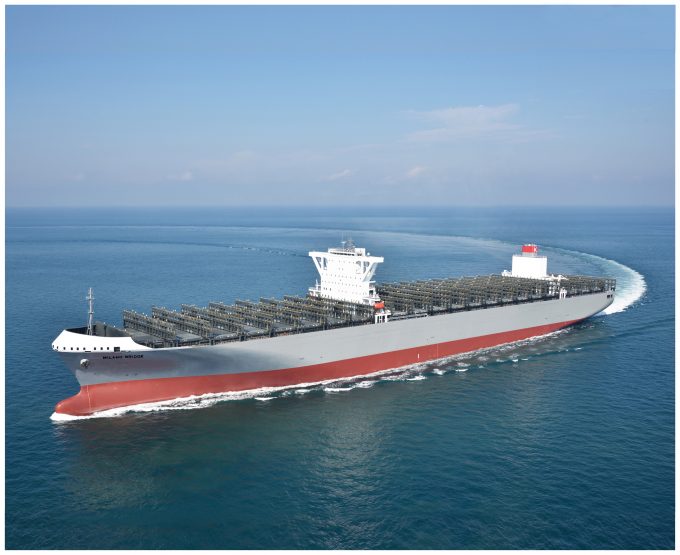Carriers look to short-term gains over blanking, as Red Sea crisis props up rates
With the Red Sea crisis continuing to artificially prop up container spot rates, carriers have ...

K Line has received the 13,900 teu Milano Bridge, the first of five sister ships to be delivered this year from the Hiroshima yard of Japan’s Imabari Shipbuilding.
The container businesses of three Japanese carriers will merge on 1 April, but K Line, along with MOL and NYK, will still be taking delivery of vessels ordered prior to the decision to consolidate their traffic into Ocean Network Express (ONE).
According to the orderbooks, MOL has one 20,182 teu ULCV to be delivered this year, while NYK is to receive a further seven 14,000 teu vessels – all will be added to the combined ONE fleet.
K Line said the Milano Bridge will be deployed on the Asia-Mediterranean MED2 service within THE Alliance network.
According to Alphaliner data, K Line owns a fleet of 12 ships with a total capacity of 80,150 teu, but charters another 47 vessels, 275,074 teu, representing some 77% of its total capacity.
MOL charters 57.7% of its fleet in terms of capacity: 52 vessels for 328,971 teu to supplement its own 27-strong fleet of 240,846 teu capacity.
NYK, on the other hand, owns 40 containerships, equating to 238,574 teu, and charters a further 55 for a capacity of 319,207 teu, or 57.2% of its operating fleet.
Based on this, the ONE merger will create the world’s sixth largest container line, at circa 1.5m teu, just behind the 1.55m teu of Hapag-Lloyd and ahead of Evergreen’s approximate 1.1m teu. After the newbuild deliveries, ONE will surpass Hapag-Lloyd as the German carrier says it has no plans to order more ships.
However, with a target of achieving synergy cost savings of $440m in the first year, extending to annualised savings of $1.1bn by year three, the new ONE management may need to look at rationalising the fleet at an early stage.
Given the percentage of chartered tonnage currently deployed, many of which will be on relatively short-term hire, ONE will have plenty of opportunity to cut out surplus tonnage.
Apart from their alliance membership, the Japanese carriers have hitherto operated competing services around the world. With other carriers circling their customers they will need to very quickly organise their commercial activity under the ONE brand in order not to suffer any undue customer seepage in the merger.
The history of M&A activity in liner shipping has been fraught with difficulties in retaining shipper support – in the aftermath of the takeover of P&O Nedlloyd by Maersk in 2005, the Danish carrier was estimated to have lost 50% of the acquired business.
Comment on this article
Andy Lane
January 23, 2018 at 2:31 pmMike, after the Maersk/P&ONL merger (Feb 2006) the aggregated market share fell by maybe 8%, which is not so uncommon. The Africa and Oceania trades suffered a bit due to the new huge market share, and some TransPacific was lost due to targeted pricing by competitors. Nothing really was lost due to operational transition.
—
Albeit through different Customers, this was regained within a reasonable time frame.
—
I think that ONE will fair better, as a lot of Japanese shippers will be loyal to what they are used to, but whatever volume might get lost, can be recovered in a multitude of different ways.